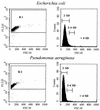Characteristics and dynamics of bacterial populations during postantibiotic effect determined by flow cytometry
- PMID: 9593117
- PMCID: PMC105733
- DOI: 10.1128/AAC.42.5.1005
Characteristics and dynamics of bacterial populations during postantibiotic effect determined by flow cytometry
Abstract
Changes in bacterial ultrastructure after antibiotic exposure and during the postantibiotic effect (PAE) have been demonstrated by electron microscopy (EM). However, EM is qualitative and subject to individual interpretation. In contrast, flow cytometry gives qualitative and quantitative information. The sizes and nucleic acid contents of Escherichia coli and Pseudomonas aeruginosa were studied during antimicrobial exposure as well as during the PAE period by staining the organisms with propidium iodide and analyzing them with flow cytometry and fluorescence microscopy. The effects of ampicillin, ceftriaxone, ciprofloxacin, gentamicin, and rifampin were studied for E. coli, whereas for P. aeruginosa imipenem and ciprofloxacin were investigated. After exposure of E. coli to ampicillin, ceftriaxone, and ciprofloxacin, filamentous organisms were observed by fluorescence microscopy. These changes in morphology were reflected by increased forward light scatter (FSC) and nucleic acid content as measured by flow cytometry. For the beta-lactams the extent of filamentation increased in a dose-dependent manner after drug removal, resulting in formation of distinct subpopulations of bacteria. These changes peaked at 20 to 35 min, and bacteria returned to normal after 90 min after drug removal. In contrast, the subpopulations induced by ciprofloxacin did not return to normal until > 180 min after the end of the classically defined PAE. Rifampin resulted in formation of small organisms with low FSC, whereas no distinctive characteristics were noted after gentamicin exposure. For P. aeruginosa an identifiable subpopulation of large globoid cells and increased nucleic acid content was detected after exposure to imipenem. These changes persisted past the PAE, as defined by viability counting. Swollen organisms with increased FSC were detected after ciprofloxacin exposure, even persisting during bacterial growth. In summary, for beta-lactam antibiotics and ciprofloxacin, the PAE is characterized by dynamic formation of enlarged cell populations of increased nucleic acid content, whereas rifampin induces a decrease in size and nucleic acid content in the organisms. Flow cytometry is an ideal method for future studies of bacterial phenotypic characteristics during the PAE.
Figures





References
-
- Ali M Z, Goetz M B. A meta-analysis of the relative efficacy and toxicity of single daily dosing versus multiple daily dosing of aminoglycosides. Clin Infect Dis. 1997;24:796–809. - PubMed
-
- Bailey T C, Little J R, Littenberg B, Reichley R M, Dunagan W C. A meta-analysis of extended-interval dosing versus multiple daily dosing of aminoglycosides. Clin Infect Dis. 1997;24:786–795. - PubMed
-
- Bigger J W. The bactericidal action of penicillin on Staphylococcus pyogens. Ir J Med Sci. 1944;227:533–568.
-
- Boswell F J, Andrews J M, Gill M J, Wise R. Postantibiotic effect of three carbapenems on Pseudomonas aeruginosa in the presence of lysine. J Antimicrob Chemother. 1995;35:232–233. - PubMed
Publication types
MeSH terms
Substances
LinkOut - more resources
Full Text Sources
Other Literature Sources
Medical
Miscellaneous

